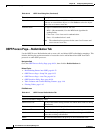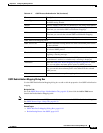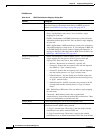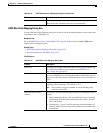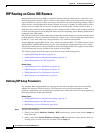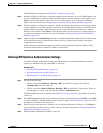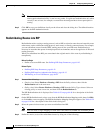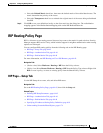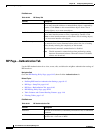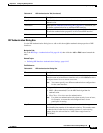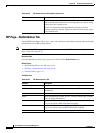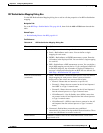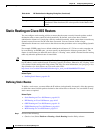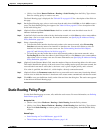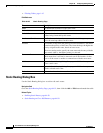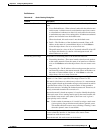
64-46
User Guide for Cisco Security Manager 4.4
OL-28826-01
Chapter 64 Configuring Routing Policies
RIP Routing Policy Page
Field Reference
RIP Page—Authentication Tab
Use the RIP Authentication tab to view, create, edit, and delete the neighbor authentication settings of
RIP interfaces.
Navigation Path
Go to the RIP Routing Policy Page, page 64-45, then click the Authentication tab.
Related Topics
• Defining RIP Interface Authentication Settings, page 64-43
• RIP Page—Setup Tab, page 64-45
• RIP Page—Redistribution Tab, page 64-48
• RIP Routing Policy Page, page 64-45
• Table Columns and Column Heading Features, page 1-46
• Filtering Tables, page 1-45
Field Reference
Table 64-20 RIP Setup Tab
Element Description
Networks The directly connected networks associated with the RIP route. Enter
one or more network addresses or network/host objects, separated by
commas. Click Select to select network/host objects from a list of
existing objects, or to create new objects.
Passive Interfaces The interfaces that do not send updates to their routing neighbors. Enter
one or more interface names or roles, separated by commas. Click
Select to select interface names or roles from a list of existing objects,
or to create new interface role objects.
Auto-Summary When selected, enables the automatic summarization of subnet routes
into network-level routes. Summarization reduces the size of routing
tables, thereby reducing the complexity of the network.
When deselected, automatic summarization is disabled.
Note Disable automatic summarization when performing routing
between disconnected subnets. When this feature is disabled,
subnets are advertised.
Table 64-21 RIP Authentication Tab
Element Description
Interfaces The name of an interface (as defined by an interface role) on which RIP
is enabled.
Authentication The type of RIP neighbor authentication that is enabled for the selected
interface role—clear text or MD5.



